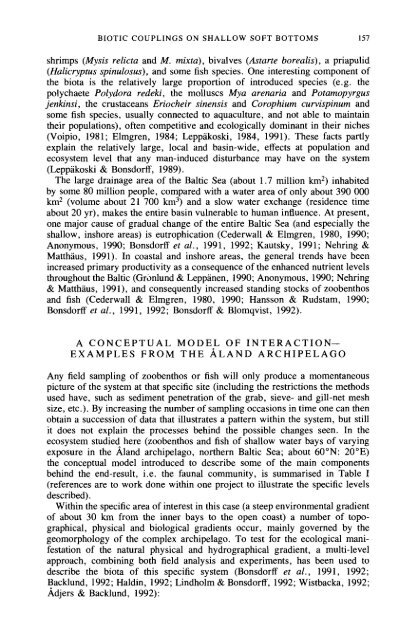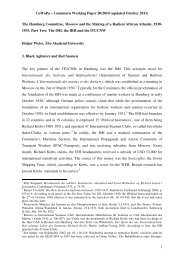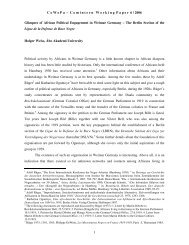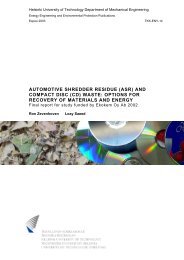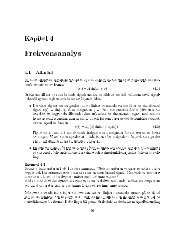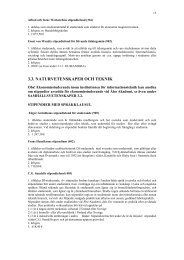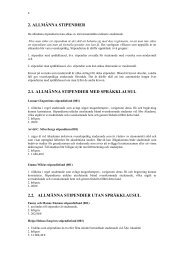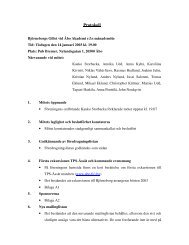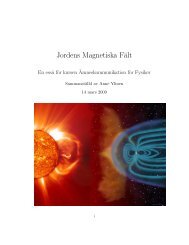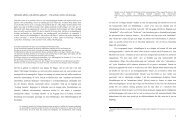biotic couplings on shallow water soft bottoms-examples from the ...
biotic couplings on shallow water soft bottoms-examples from the ...
biotic couplings on shallow water soft bottoms-examples from the ...
You also want an ePaper? Increase the reach of your titles
YUMPU automatically turns print PDFs into web optimized ePapers that Google loves.
BIOTIC COUPLINGS ON SHALLOW SOFT BOTTOMS 157<br />
shrimps (Mysis relicta and M. mixta), bivalves (Astarte borealis), a priapulid<br />
(Halicryptus spinulosus), and some fish species. One interesting comp<strong>on</strong>ent of<br />
<strong>the</strong> biota is <strong>the</strong> relatively large proporti<strong>on</strong> of introduced species (e.g. <strong>the</strong><br />
polychaete Polydora redeki, <strong>the</strong> molluscs Mya arenaria and Potamopyrgus<br />
jenkinsi, <strong>the</strong> crustaceans Eriocheir sinensis and Corophium curvispinum and<br />
some fish species, usually c<strong>on</strong>nected to aquaculture, and not able to maintain<br />
<strong>the</strong>ir populati<strong>on</strong>s), often competitive and ecologically dominant in <strong>the</strong>ir niches<br />
(Voipio, 198 1; Elmgren, 1984; Lepp&oski, 1984, 199 1). These facts partly<br />
explain <strong>the</strong> relatively large, local and basin-wide, effects at populati<strong>on</strong> and<br />
ecosystem level that any man-induced disturbance may have <strong>on</strong> <strong>the</strong> system<br />
(Leppakoski & B<strong>on</strong>sdorff, 1989).<br />
The large drainage area of <strong>the</strong> Baltic Sea (about 1.7 milli<strong>on</strong> km2) inhabited<br />
by some 80 milli<strong>on</strong> people, compared with a <strong>water</strong> area of <strong>on</strong>ly about 390 000<br />
km2 (volume about 21 700 km3) and a slow <strong>water</strong> exchange (residence time<br />
about 20 yr), makes <strong>the</strong> entire basin vulnerable to human influence. At present,<br />
<strong>on</strong>e major cause of gradual change of <strong>the</strong> entire Baltic Sea (and especially <strong>the</strong><br />
<strong>shallow</strong>, inshore areas) is eutrophicati<strong>on</strong> (Cederwall & Elmgren, 1980, 1990;<br />
An<strong>on</strong>ymous, 1990; B<strong>on</strong>sdoriT et al., 1991, 1992; Kautsky, 1991 ; Nehring &<br />
Matthaus, 1991). In coastal and inshore areas, <strong>the</strong> general trends have been<br />
increased primary productivity as a c<strong>on</strong>sequence of <strong>the</strong> enhanced nutrient levels<br />
throughout <strong>the</strong> Baltic (Grbnlund & Leppanen, 1990; An<strong>on</strong>ymous, 1990; Nehring<br />
& Matthaus, 1991), and c<strong>on</strong>sequently increased standing stocks of zoobenthos<br />
and fish (Cederwall & Elmgren, 1980, 1990; Hanss<strong>on</strong> & Rudstam, 1990;<br />
B<strong>on</strong>sdorff et al., 1991, 1992; B<strong>on</strong>sdorff & Blomqvist, 1992).<br />
A CONCEPTUAL MODEL OF INTERACTION-<br />
EXAMPLES FROM THE ALAND ARCHIPELAGO<br />
Any field sampling of zoobenthos or fish will <strong>on</strong>ly produce a momentaneous<br />
picture of <strong>the</strong> system at that specific site (including <strong>the</strong> restricti<strong>on</strong>s <strong>the</strong> methods<br />
used have, such as sediment penetrati<strong>on</strong> of <strong>the</strong> grab, sieve- and gill-net mesh<br />
size, etc.). By increasing <strong>the</strong> number of sampling occasi<strong>on</strong>s in time <strong>on</strong>e can <strong>the</strong>n<br />
obtain a successi<strong>on</strong> of data that illustrates a pattern within <strong>the</strong> system, but still<br />
it does not explain <strong>the</strong> processes behind <strong>the</strong> possible changes seen. In <strong>the</strong><br />
ecosystem studied here (zoobenthos and fish of <strong>shallow</strong> <strong>water</strong> bays of varying<br />
exposure in <strong>the</strong> Aland archipelago, nor<strong>the</strong>rn Baltic Sea; about 60°N: 20°E)<br />
<strong>the</strong> c<strong>on</strong>ceptual model introduced to describe some of <strong>the</strong> main comp<strong>on</strong>ents<br />
behind <strong>the</strong> end-result, i.e. <strong>the</strong> faunal community, is summarised in Table I<br />
(references are to work d<strong>on</strong>e within <strong>on</strong>e project to illustrate <strong>the</strong> specific levels<br />
described).<br />
Within <strong>the</strong> specific area of interest in this case (a steep envir<strong>on</strong>mental gradient<br />
of about 30 km <strong>from</strong> <strong>the</strong> inner bays to <strong>the</strong> open coast) a number of topo-<br />
graphical, physical and biological gradients occur, mainly governed by <strong>the</strong><br />
geomorphology of <strong>the</strong> complex archipelago. To test for <strong>the</strong> ecological mani-<br />
festati<strong>on</strong> of <strong>the</strong> natural physical and hydrographical gradient, a multi-level<br />
approach, combining both field analysis and experiments, has been used to<br />
describe <strong>the</strong> biota of this specific system (B<strong>on</strong>sdorff et al., 1991, 1992;<br />
Backlund, 1992; Haldin, 1992; Lindholm & B<strong>on</strong>sdorff, 1992; Wistbacka, 1992;<br />
Adjers & Backlund, 1992):


